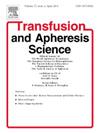受供体因素影响的 RCC 中的红细胞亚群。
IF 1.4
4区 医学
Q4 HEMATOLOGY
引用次数: 0
摘要
了解红细胞(RBC)亚群对于理解供体变异和提高输血效果至关重要。本综述强调了红细胞亚群的重要意义,重点介绍了生物学上年轻和衰老红细胞的特性,并强调了供体变异如何影响输血结果。文章还讨论了衰老 RBC 在输血不良反应中的作用以及循环红细胞 (CEC) 的新意义。重点介绍了红细胞的衰老以及氧化应激和衰老机制的作用。RBC 弹性、钙稳态、带 3 蛋白修饰、膜微vesiculation、2,3-二磷酸甘油酯(2,3-DPG)水平以及 CD47 和 CD55 等免疫标记物的变化有助于 RBC 的清除和红细胞吞噬。此外,还介绍了表征/分离生物学上年轻和年老的 RBC 亚群的方法。本综述强调了 RBC 亚群在了解供体变异性和改善输血结果方面的重要性。本文章由计算机程序翻译,如有差异,请以英文原文为准。
RBC subpopulations in RCCs affected by donor factors
Understanding red blood cell (RBC) subpopulations is crucial for comprehending donor variability and enhancing transfusion outcomes. This review highlights the significance of RBC subpopulations, focusing on the properties of biologically young and old RBCs and underscores how donor variability impacts transfusion outcomes. The role of senescent RBCs in adverse transfusion reactions and the emerging significance of circulating erythroid cells (CECs) is discussed. RBC aging and the role of oxidative stress and aging mechanisms is highlighted. Changes in RBC flexibility, calcium homeostasis, band 3 protein modifications, membrane microvesiculation, 2,3-diphosphoglycerate (2,3-DPG) levels, and immunological markers like CD47 and CD55 contribute to RBC clearance and erythrophagocytosis. Also, methods of characterizing / separating of biologically young and old RBC subpopulations is introduced. This review emphasizes the importance of RBC subpopulations in understanding donor variability and improving transfusion outcomes.
求助全文
通过发布文献求助,成功后即可免费获取论文全文。
去求助
来源期刊
CiteScore
3.60
自引率
5.30%
发文量
181
审稿时长
42 days
期刊介绍:
Transfusion and Apheresis Science brings comprehensive and up-to-date information to physicians and health care professionals involved in the rapidly changing fields of transfusion medicine, hemostasis and apheresis. The journal presents original articles relating to scientific and clinical studies in the areas of immunohematology, transfusion practice, bleeding and thrombotic disorders and both therapeutic and donor apheresis including hematopoietic stem cells. Topics covered include the collection and processing of blood, compatibility testing and guidelines for the use of blood products, as well as screening for and transmission of blood-borne diseases. All areas of apheresis - therapeutic and collection - are also addressed. We would like to specifically encourage allied health professionals in this area to submit manuscripts that relate to improved patient and donor care, technical aspects and educational issues.
Transfusion and Apheresis Science features a "Theme" section which includes, in each issue, a group of papers designed to review a specific topic of current importance in transfusion and hemostasis for the discussion of topical issues specific to apheresis and focuses on the operators'' viewpoint. Another section is "What''s Happening" which provides informal reporting of activities in the field. In addition, brief case reports and Letters to the Editor, as well as reviews of meetings and events of general interest, and a listing of recent patents make the journal a complete source of information for practitioners of transfusion, hemostasis and apheresis science. Immediate dissemination of important information is ensured by the commitment of Transfusion and Apheresis Science to rapid publication of both symposia and submitted papers.

 求助内容:
求助内容: 应助结果提醒方式:
应助结果提醒方式:


